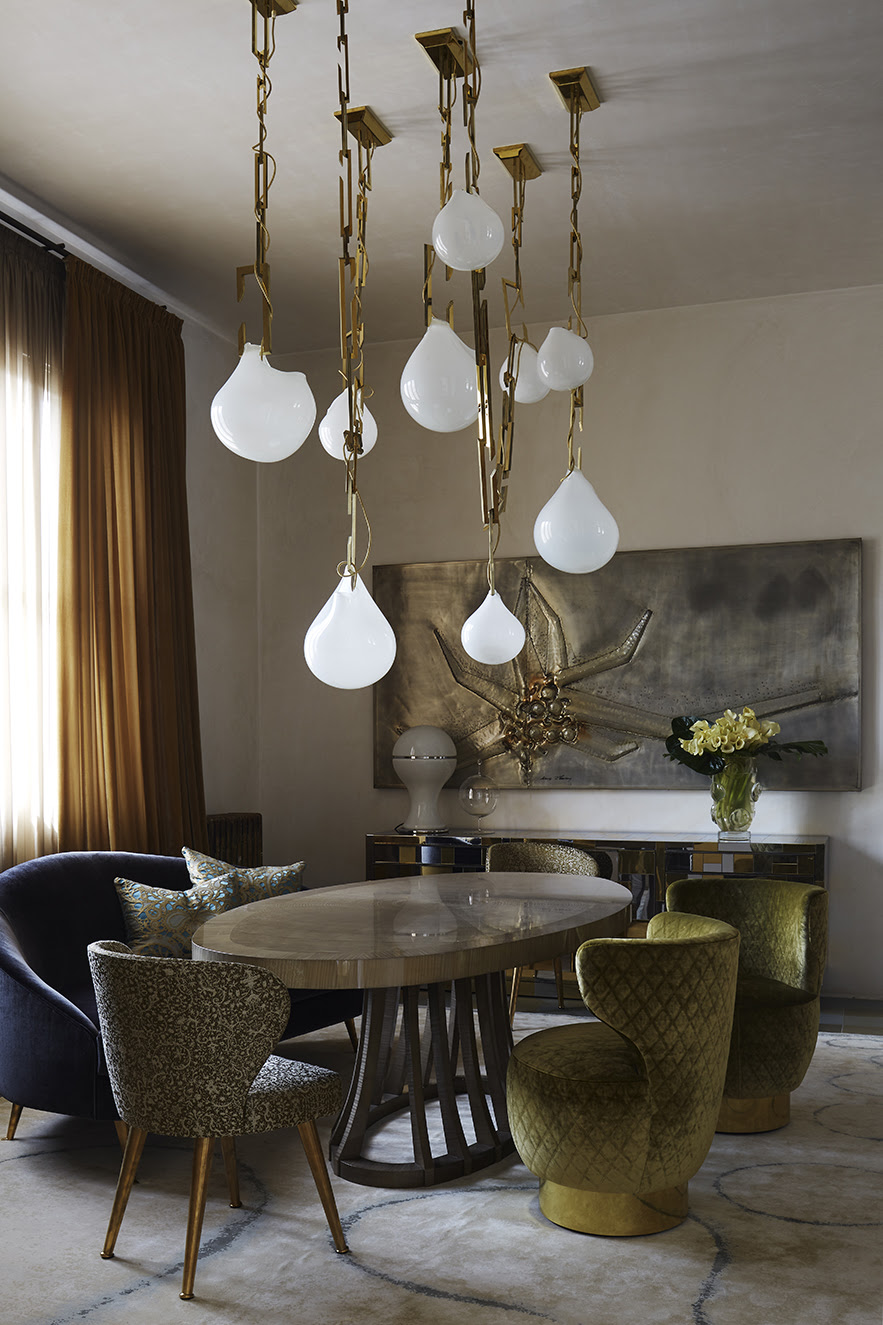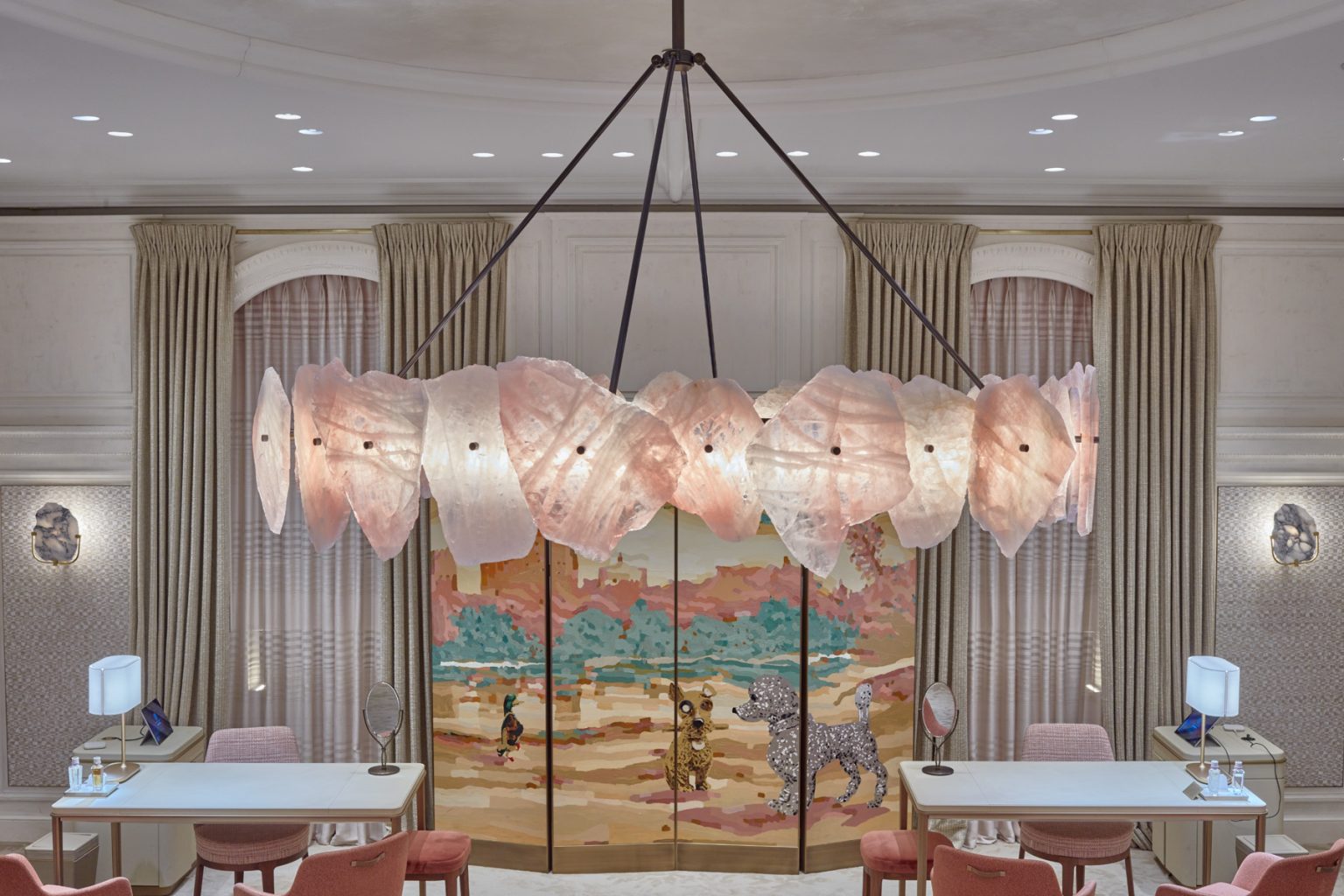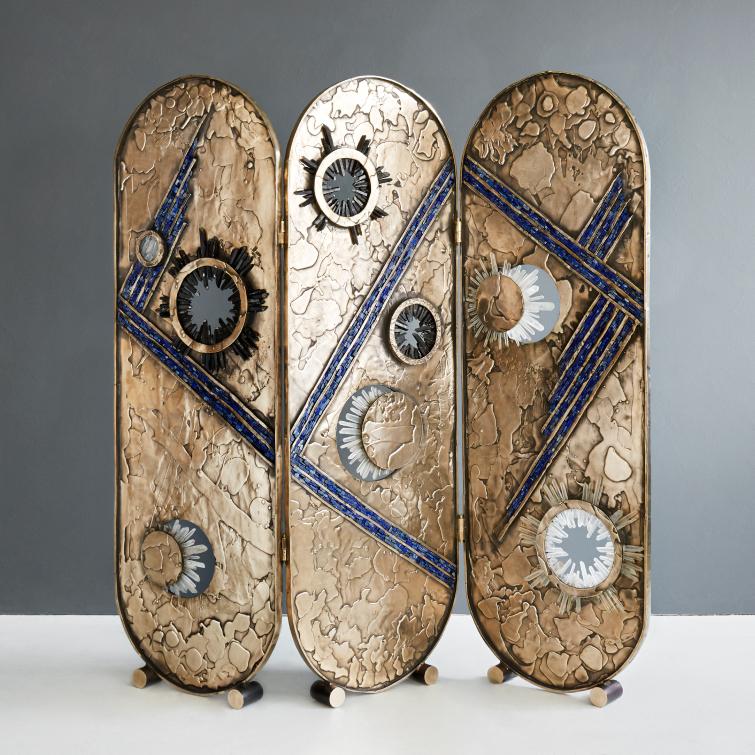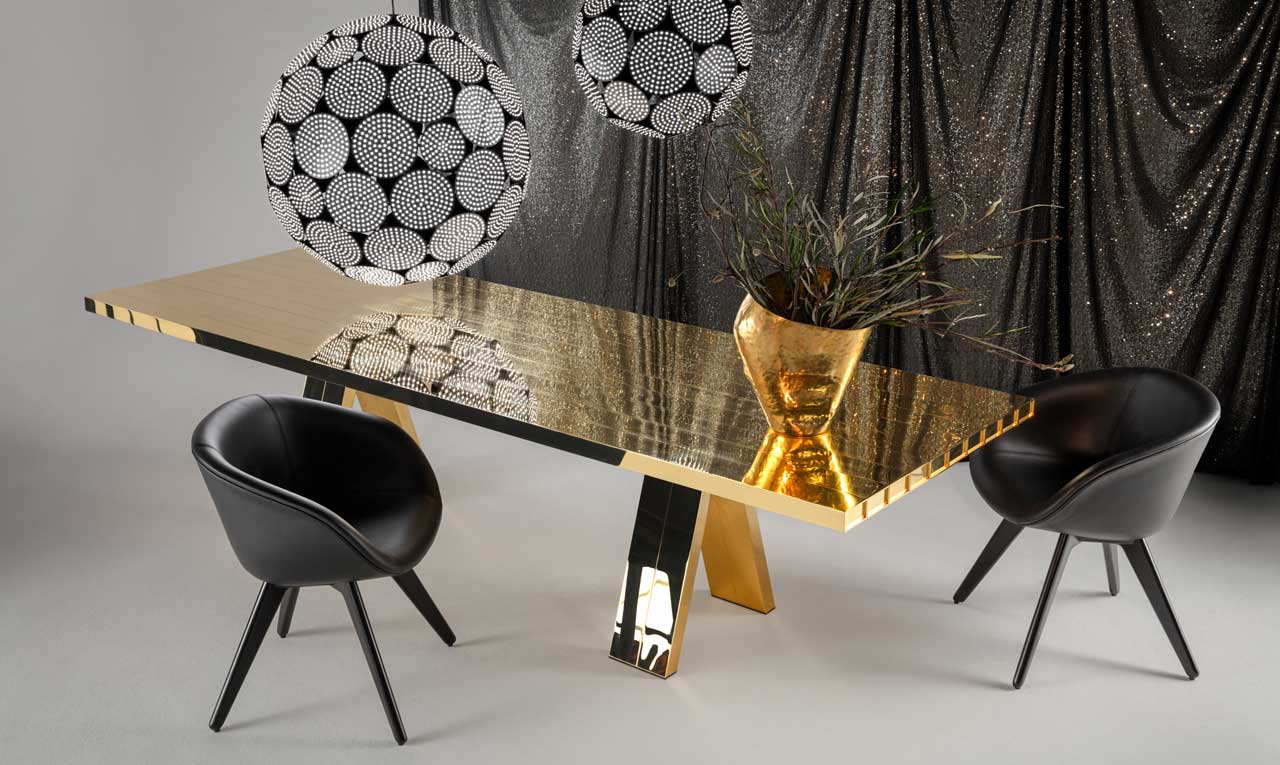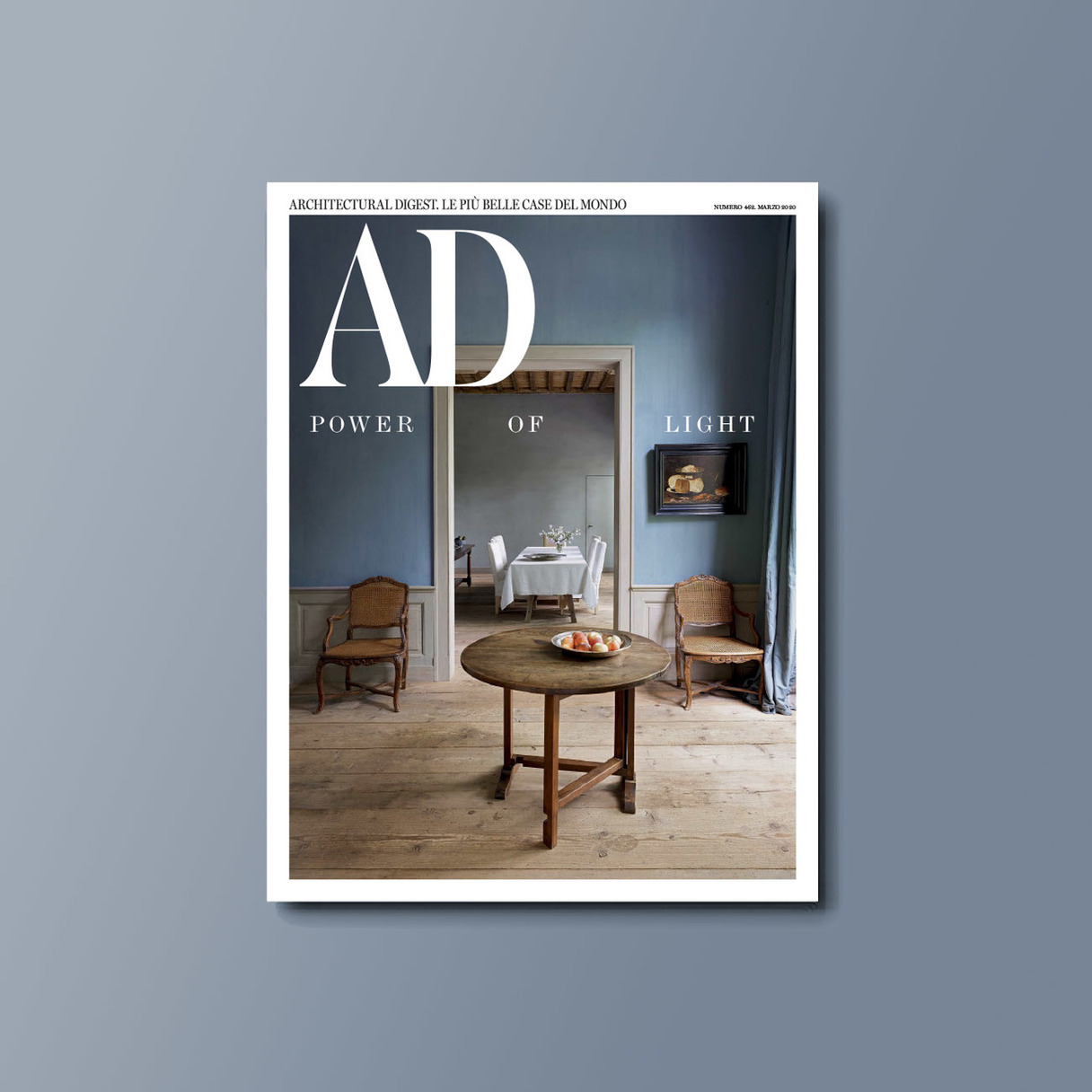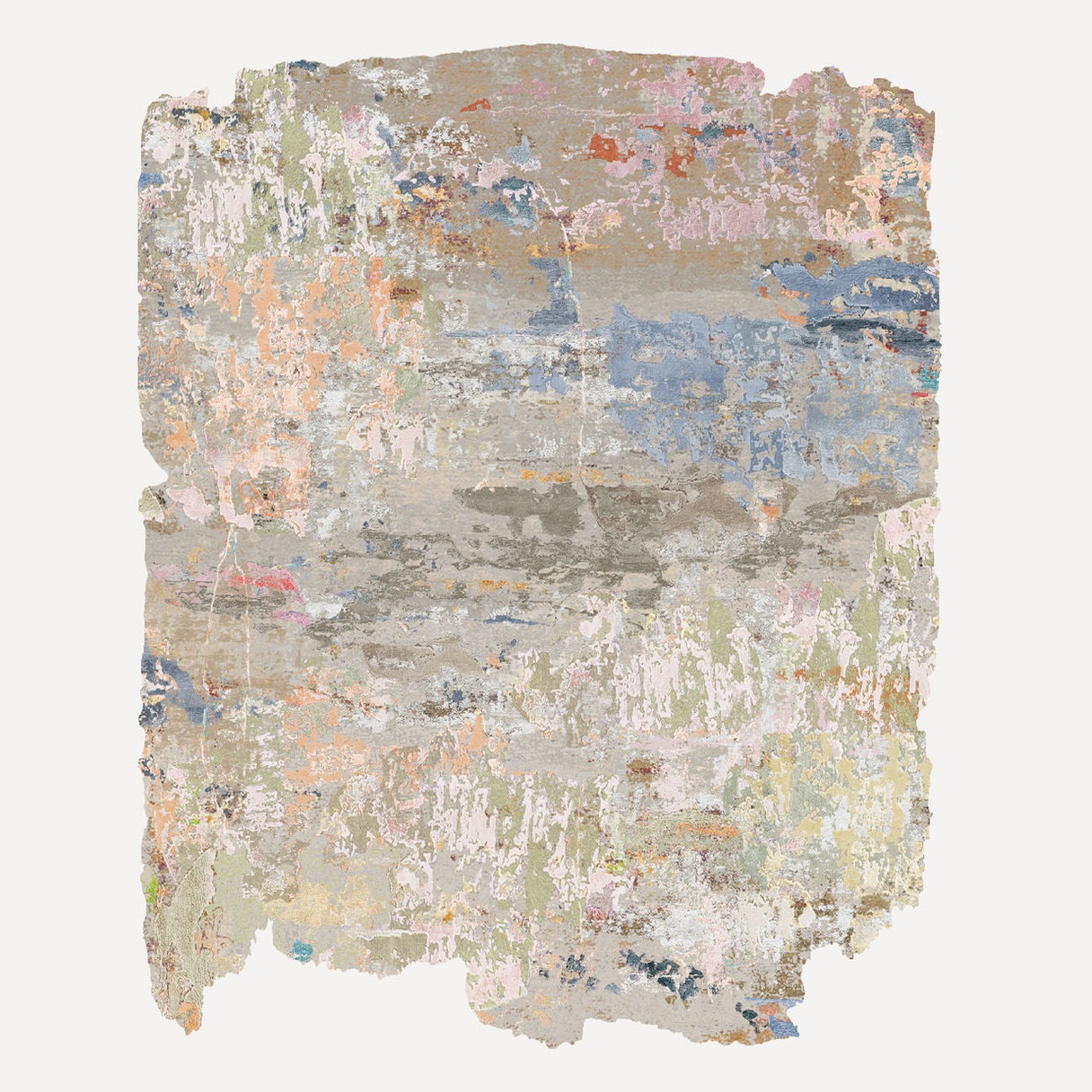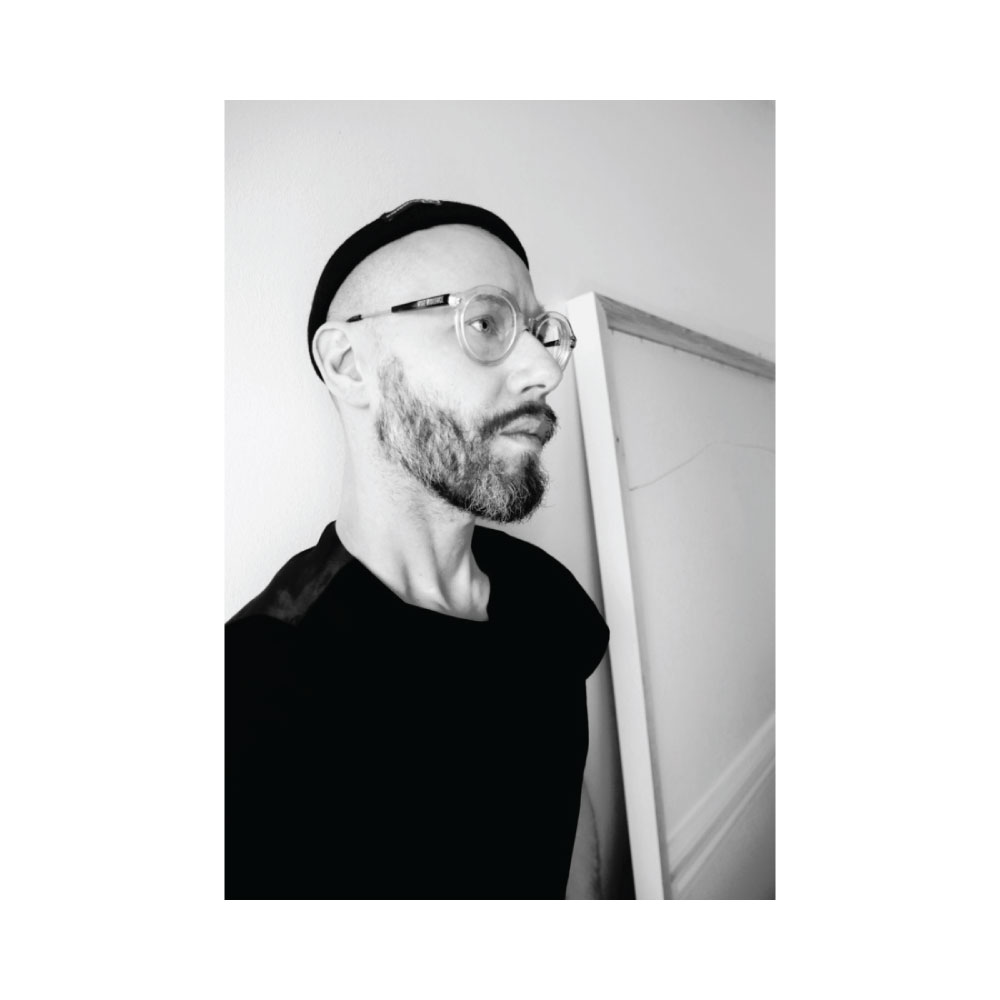Press
- February 06, 2024
Often Shining with Quartz Crystal, Christopher Boots’s Work has a Timeless, Elemental Feel
BY IAN PHILLIPS
The designer mixed classical and contemporary when crafting the apartment for a family of four.
Australian maker CHRISTOPHER BOOTS, seen here in his Melbourne-area studio, creates minimalist lighting that’s frequently inspired by Greek myths (photo by John Tsiavis). Top: His PROMETHEUS I and II chandeliers are made of brass rings set with QUARTZ crystals (photo courtesy of Christopher Boots).
Lighting designer CHRISTOPHER BOOTS is a little embarrassed to admit it, but he doesn’t have overhead lighting in his bedroom. “I could have had a great CHANDELIER, but the joiners covered the ceiling with Baltic pine, and we couldn’t really drill through it to poke around for the cables,” he says. So, he makes do with candles and plug-in lamps.
Since setting up his Melbourne studio, more than 12 years ago, Boots has firmly established himself as one of Australia’s leading lights, so to speak, in design. He has received commissions from HERMÈS, CASSINA and Milan’s GALLERIA ROSSANA ORLANDI and has placed three chandeliers in CARTIER’s Sydney flagship store, including an installation for the stairwell made from clear crystal QUARTZ and sand-cast bronze with forms inspired by coral and stalactites. The lobby of the Ritz-Carlton, Melbourne, displays his Phasmida pendant lights, and one of the suites at the legendary Badrutt’s Palace hotel in St. Moritz is graced by his PROMETHEUS CHANDELIER.
Los Angeles–based interior designer OHARA DAVIES-GAETANO recently chose a Boots Nepenthes ceiling fixture for a house in Laguna Beach. “Christopher’s work is very expressive and evokes a magical emotional resonance due to its materiality,” she notes. “The combination of crystals, blown glass and metal melded into poetic forms elicits a sense of wonder.”
The combination of crystals, blown glass and metal melded into poetic forms elicits a sense of wonder
The names of many of Boots’s creations hark back to Greek mythology. According to his website, Nepenthes is “a magical substance that quells all sorrows”; the chandelier named for it consists of chains — some vertical, others parabolic — hung with bulbous, milky spheres. Prometheus, named for the Titan who gave fire to humankind, consists of a large brass ring to which dozens of small quartz crystals are affixed so that it resembles a circle of flame when lit. The ceiling lights and sconce in the Ouranos collection incorporate perfect quartz spheres (Ouranos is the mythological personification of the sky).
Several of the designer’s Nepenthes pendants adorn a home in South Yarra, Australia. Photo by Christine Francis
Boots’s love of ancient Greece no doubt has something to do with his heritage. His maternal grandparents were of Greek origin, and he lived in the country for a couple of years during his childhood. At around the age of seven, he received a book on mythology, which he still owns. “I loved that stuff — I ate it all up,” he says. Another early passion was natural stones. He still remembers finding a crystal on a beach as a child in the mid-’80s. “I was like, ‘Wow! What is this thing?’ I got totally entranced by the whole world of rocks.”
That enchantment has developed into a particular love of quartz crystal — the material Boots uses most in his work. He has said that it represents “the beauty of geological time,” and during a Zoom interview, he goes to a corner of his office to pick up two huge chunks. “They’re incredible,” he says. “The transmission of light is amazing.”
A stairway in CARTIER‘s Sydney flagship store winds around a dramatic grouping of Boots’s Stalactite pendants. Photos by Nic Gossage
Boots explains that he specialized in lighting because of the way it affects our experience of space. “My pieces should be making you feel soft, ambient, like you could be in a drama or a mystery or an intrigue,” he says. “That’s what we’re missing in this world.” He created his first illuminated piece at the age of 10, when he collected sea urchin shells and glued them to the Christmas lights. By 15, he was making lamps from computer chips, cast concrete and X-rays; for his 18th birthday, he received a welder, with which he fashioned chairs and tables from discarded rebar.
Made with slices of pink quartz, a Petra pendant enhances the rosy decor in a room at the Cartier mansion on New York’s Fifth Avenue. Photo by the Behrens
He went on to study design at the Swinburne University of Technology and, upon graduation, joined the studio of local iconoclastic lighting designer Geoffrey Mance. Mance “experimented with unexpected and thought-provoking materials and processes,” Boots recalls. “He taught me to lean into experimentation and not be limited by fear.”
He taught me to lean into experimentation and
not be limited by fearAfter Mance’s death, in 2007, Boots stayed at the studio for four more years before launching his own firm. Initially, he worked out of a 500-square-foot space with just a friend to help him. Today, his headquarters is in a 1940s 15,000-square-foot former printing shop in Melbourne’s Fitzroy district, where he oversees a team of roughly 35.
Boots hand assembles an Ouranos chandelier, composed of quartz-crystal spheres suspended in a brass fixture. Photos by Matt McQuiggan
In conversation, Boots is wonderfully animated and voluble. On his desk sits a vintage TABLE LAMP manufactured by the Italian firm BILUMEN, and on the shelves behind it is a book on VIENNA SECESSION architect ADOLF LOOS. Also in his office are a bust of Hermès, a table covered with rock and crystal samples and a shelf laden with CERAMICS, including a mug by Los Angeles–based sculptor Ben Medansky and a pitcher Boots picked up at a Paris flea market. The majority of his production is carried out by hand in the adjacent workshops, although he collaborates with a neighboring foundry for metalwork.
Boots often compares his lighting creations to GEMS. “I’m basically doing jewelry on a larger scale,” he says. He tends to keep his designs simple. “I try to be as reductive and purist as possible, because in my world, you need to honor the material,” he explains. He generally sticks to elementary geometric forms, whether circles, prisms or straight lines, with the only irregularities those introduced by the addition of his beloved quartz crystals.
In addition to lighting, Boots has made a few exceptional and intricate pieces of furniture, including his Curiosity cabinet, left, and Vanity screen, right. Photos, from left, by Guy Lavoipierre and Christine Francis
He is currently busy exploring different types of glass. “Ultimately, I’d love to be able to cast our own out of the refuse from the local area,” he says. He is also thinking of branching out more into furniture design. To date, he has created only a couple of highly crafted pieces — his stunning Curiosity cabinet, encrusted with LAPIS LAZULI, and his Vanity screen, which took him four years to complete and features a moon-like surface cast in solid bronze.
More than anything, Boots’s goal is to make objects that last. “What’s the point of making landfill when you can make heirlooms?” he asks. He sometimes plays with the idea that his designs may be sold at Christie’s in 2200 and, when asked which will best stand the test of time, names the Diamond ring chandelier, consisting solely of a circle of sparkling quartz crystals. “It’s so simple that it will never date,” he says. “It’s something that would look as good in a neolithic setting as it would in a space station.”
Christopher Boots at Twentieth Gallery
- August 29, 2023
Architectural Digest | Winnie Harlow’s Glamorous LA Home Is a Dreamy Sanctuary
- April 07, 2023
ROSS GARDAM CREATES NEW PAVILION SPACE & UNVEILS ROSS GARDAM EDITIONS.
The Pavilion, a new digital space created by Ross Gardam to exhibit the brand’s expanding portfolio. Visualisations by Mr.P Studios.
Visualisations by Mr.P Studios.
Visualisation by Mr.P Studios.
Step into the Ross Gardam universe. The Melbourne-based industrial designer has created the Pavilion, a digital space to exhibit his brand’s expanding portfolio of furniture and lighting. Set amongst the dense Australian bushland, the imagined space exists between the physical and digital, offering an open-ended exploration of the nature of beings, objects and place—and how they all connect.
Created in tandem with Melbourne-based digital agency Mr. P, the Pavilion enables people to transport themselves to a spatial experience that defies time and place, showcasing an array of original ideas that question convention. Expanding on the digital space, the Pavilion can also be a vehicle to collaborate with other creatives as the brand releases new collections annually.
The inspiration behind the Pavilion stems from Gardam’s long-standing fascination with brutalist architecture. In particular, the honesty and monolithic sense of grandeur. “I am always enamoured by brutalist structures, the volume and scale of what typically is a singular gesture in form,” Ross explains. “This informed many of my products and was an easy choice as a point of inspiration for the Pavilion.”
Visualisations by Mr.P Studios.
Visualisations by Mr.P Studios.
Visualisations by Mr.P Studios.
The façade is open, expansive and inviting, drawing focus first to the curved entry, followed by the beams which compel people to continue through the interior until arriving at the internal courtyard of the atrium. The atrium, in turn, transitions to the Australian bushland outside. Emphasis was put on minimalism, using concrete in situ as the base material. Creating contrast was vital, as seen in the curved roof detail, which softened the walls and beams leading to the atrium. To establish an intuitive sense of flow, the horizontal planes, beams and external uprights were secured via a physical cut-out of the façade for the beams to sit. Each element seamlessly locks together through this singular interaction—ultimately unifying the building.
As a space providing scale and form for staging Gardam’s designs, careful consideration was given to curating the furniture and lighting inside—including the journey to discover them. This reflects Gardam’s belief that objects are not meant to exist in isolation but rather in relation to ourselves and our surroundings. To this end, the interior consists of four rooms with interconnected views to one another, as well as the internal courtyard and the exterior. This simultaneous view of each adjacent space adds to the intrigue, triggering curiosity for people to explore the entire interior, leading out to the Australian landscape.
Intrinsic to the architecture of the Pavilion was the idea of incorporating nature, both outside and inside, as part of the narrative. The external environment reveals the location as unmistakably Australian—with eucalyptus trees, native ferns and other foliage surrounding the exterior and providing unique portals from the oversized apertures of the Pavilion.
The limited edition Hemera Table Lamp, available in deep green. Photo by Haydn Cattach.
Photo by Haydn Cattach.
Photo by Haydn Cattach.
Photo by Haydn Cattach.
The building has been photographed at various intervals throughout the day, allowing people to experience subtle nuances in the play of light on Gardam’s furniture and lamps in situ. In doing so, this displays the sculptural appeal of the lamps during the day when switched off and the various moods and types of light they emit in the evening when illuminated. The internal images were taken early in the morning when fog engulfed the Pavilion. External ones were captured in the full afternoon sun, followed by more intimate lighting in photos taken at dusk.
Alongside the Pavilion, Ross releases a limited edition of the Hemera Table Lamp made from a signature Accorsi-honed marble in a deep green. Powerful in its simplicity of form, the apt release of only three pieces is inspired by brutalist architecture. The two solid circular volumes intersect with no overtly visible light source, creating a striking desktop monolith and a lighting device of refined functionality. Hemera Accorsi is a collaboration with New Volumes.
To find out more about the Pavilion and to see it in action, head to Ross Gardam’s new website.
- March 18, 2022
Galerie Magazine | Creative Mind: Lara Bohinc
Lara Bohinc
The jewelry designer turned furniture maker has found inspiration in everything from the cosmos to the pandemic for her eye-catching creations recently presented at Design Miami/
Lara Bohinc's Moonrise sconce, Kissing armchair, and Profiterole small coffee table in Nero Marquina marble.
Highly sought after for her celestial-inspired lighting and sumptuous furniture pieces, Lara Bohinc began her career on a much smaller scale. She spent years designing remarkable bijoux for Lanvin and Gucci and serving as a creative consultant for Cartier. Transforming her Planetaria jewelry collection into an intoxicating array of lighting set her on a new path. Bohinc made her furniture debut with the Solaris Kinetic table during 2014’s Salone del Mobile. Most recently, she introduced Moonrise, a puzzle-like selection of lighting, available at Roll & Hill, and premiered Afternoon Tea at the London Design Festival in 2021, then presented it at Design Miami/.
Influences: “The collections can be inspired by many different things. Sometimes it can be just a simple idea, like how do you make a 3D shape out of a 2D circle? The movement of the planets is also something that I’ve been really fascinated by. But Afternoon Tea came from a time of isolation when I wanted the objects to make you feel loved.”
Lara Bohinc's Kissing sofa and Moonrise chandelier.
What’s Next: “We’re going to be showing part of a new collection during Alcova in Milan. I call it Peachy; it’s very feminine and curvier than before.”
Lara Bohinc’s Profiterole occasional and cocktail tables. Trevor dining chair by Lara Bohinc.
- November 30, 2021
Jwan Yosef x Henzel Studio Limited Edition Collection Launch / Architectural Digest
Artist Jwan Yosef in his Los Angeles studio.
Masking tape, duct tape, and blue painter’s tape might not seem inspirational in and of themselves, but in the hands of Jwan Yosef, these pedestrian materials have been transformed into paintings and sculptural installations that, he says, “conceptually hold a room together, in a very naïve and playful way.” The Syrian-born artist’s series of “masking” paintings debuted in 2014 at Stene Projects in Stockholm (his family immigrated to Sweden when he was just two years old), followed a few years later by installations at Guerrero Projects in Houston and the Bomb Factory Art Foundation, a nonprofit he cofounded while living in London, where he earned a Master’s in Fine Art at Central Saint Martins.
But it’s Yosef’s latest iteration of this concept that might actually hold rooms together—a collaboration with Henzel Studio on a collection of limited-edition carpets. It’s his first foray into the home design realm, and he’s in very good company. Henzel Studio was founded over two decades ago in Sweden and has become world-renowned for realizing the work of notable contemporary artists in luxury carpets. Their previous collaborations resulted in pieces with Marilyn Minter, Mickalene Thomas, Richard Prince, Nan Goldin, and Jack Pierson.
A portrait of the artist Jwan Yosef.
Yosef’s Masking, Masking #1 and Masking #2 are free-form cream-colored pieces with variable pile heights that create the effect of layered masking tape; Duct, Duct #1 and Duct #2 are the same idea in shades of gray; Electrical, Electrical #1 and Electrical #2 in black. Each is a numbered edition of 20 with one artist’s proof. Painter’s is a singular design, also in a numbered edition of 20, realized in shades of cobalt blue. Yosef, who now lives in Los Angeles with his husband, the singer-songwriter Ricky Martin, and their children, has said “I don’t really consider this carpet as two-dimensional. I worked with masking tape as a reference and the carpet became a pretty accurate three-dimensional imitation of that real object. The elevations of the crossing pieces of ‘tape’ are pretty real in proportions.”
Joakim Andreasson, Curator of Henzel Studio Collaborations, first reached out to Yosef three years ago. “With both of us being Swedish and living in L.A., there was instant common ground, and the creative process started right there and then,” he recalled of their initial meeting. “I was instantly drawn to Jwan’s ability to apply a different physical appropriation of his work with tape, and we both saw the potential for stunning rugs unlike anything out there. The concept also allowed us to create variations in terms of type of tape, which determines color, and shape, both of which we have explored.”
Jwan Yosef, Painters, 2021. Hand-knotted silk rug (edition of 20 + 1 AP), 170 x 300 cm (65 x 130 in).
Yosef, whose first name means “beautiful” in Kurdish, began the process as many do, with a sketch. But he “sketched” by putting masking tape directly on pieces of paper, layering the strips to create dimensional designs that he then scanned and digitized before they were transformed into hand-woven silk carpets. Andreasson, by now a veteran of this very specific sector, was especially excited about the results. “I have worked with nearly 40 artists across medias, and each provides its set of circumstances to explore, but our work with Jwan is amongst the most unique and, in turn, challenges the media at hand.”
Detail image of: Jwan Yosef, Masking, 2018. Hand-knotted silk rug (edition of 20 + 1 AP), 165 x 300 cm (65 x 130 in).
Coinciding with the debut of the carpets is a virtual exhibition of Yosef’s works at Frozen Palms Gallery, a contemporary art gallery also under the Henzel umbrella, with outposts in Los Angeles and Bastad, Sweden. “Object/Object,” is curated by Andreasson and Brianna Bakke, and will feature Yosef’s paintings and wall reliefs, as well as the hand-knotted rugs, that viewers can experience as though they were physically walking through a gallery, thanks to 3D technology powered by Artland. The rugs will also be on view at Twentieth in Los Angeles and Italo Design in Miami.
“Object/Object” runs through February 9, 2022.
- October 01, 2020
Aura lights by Sabine Marcelis for Established & Sons
Rotterdam-based designer Sabine Marcelis has designed two lights for Established & Sons made from cylindrical bars of pastel-hued resin.
Over a metre in length, each light has been formed from cylindrical tubes of bio-epoxy resin made using byproducts from the agricultural industry.
Coloured in soft tones of yellow and coral, the translucent Aura lights take their name from the warm glow they emit when illuminated.
Sabine Marcelis' Aura lights are made from tubes of bio-epoxy resin
The Aura lights form part of Established & Sons' new Live/Work collection, which the brand has developed in response to the "increasingly blurred lines between living and working environments".
Designed to be suspended from the ceiling, the Aura lights can stand alone or be positioned as part of a group composition.
A replaceable glass LED tube inside the resin casing emits a soft ambient light that is "easy on the eyes", making them suitable for home-working environments as well as relaxed living spaces.
The Aura lights were designed for Established & Sons' new Live/Work collection
"My work is currently exclusively available via galleries and this is the first step towards making some lighting available to a wider audience, but in a conscious and sustainable manner," said Marcelis.
Product: Aura
Designer: Sabine Marcelis
Brand: Established & Sons - May 13, 2020
Bocci unveils latest lighting collections at VDF
Clusters of sculptural glass pendants adorn the Armature chandelier, one of three lighting products Bocci has launched at the VDF products fair today.
The other collections unveiled by the Canadian design and manufacturing company are named Table Lamp and Stem Series, which are also decorated with blown-glass shades drawn from Bocci's collections of pendant lights.
Bocci is introducing three collections during VDF including Table Lamp (above) and Armature (top)
All three collections are now live at the VDF products fair, which has been launched as an affordable way for designers and brands to launch new products.
One of the products, named Armature, is a contemporary and customisable chandelier. It is composed of modular matte-black branches that can be connected in various arrangements and decorated with one of three different styles of glass pendants.
Stem Series has also been unveiled at the products fair
The smallest product launched by Bocci at the fair is the Table Lamp, which marries a single sculpted glass shade with a smooth brass base. It can also be wall-mounted.
Bocci's final collection launched at the products fair is the Stem Series, which comprises three different styles of lighting including ceiling fixtures and floor lamps. They are all enveloped by clusters of pendants and available in different sizes in either a black or brass finish.
- April 27, 2020
Ceto: A moment of nostalgia, illuminated
Australian lighting and furniture designer, Ross Gardam unveils the Ceto collection – the brand’s biggest luminaire range to date.
There is a magic to the times spent on the coast. The mysterious and majestic stirring of the water, the soundtrack of breaking waves and the fresh scent of sea salt can create a picturesque moment of bliss unlike any other.
On a weekend away along the shore, Melbourne-based designer, Ross Gardam was intrigued by the soul of the water with its ability to move so effortlessly in a natural and transitional way. Born from a deep love for the coast and a myriad of trace sketches, the new Ceto Collection by Ross Gardam captures the variation and rippling of the ocean’s surface in a powerful and extraordinary lighting range.
The biggest collection under the Ross Gardam name to date, Ceto represents a milestone for the Australian lighting and furniture brand. The complete range of Ceto luminaires spans chandeliers, floor lamps, wall lighting and pendant varieties – creating a cohesive story unparallel to any other collection within the brand.
“Ceto is the result of a concept that took over 12 months to develop. It’s mesmerising story and unique characteristics needed the right amount of time to craft. In this time, I was able to discover and explore the true essence of a concept that was very special to me,” expresses Gardam.
Each piece in the Ceto collection reflects a distinct pattern, emitting a delicate luminosity. The various configurations of the products make it a truly universal light; meticulously crafted with the intentions to perform, entice and inspire all at once. The pieces are sculptural in form – strikingly minimal with an engaging artistic spirit that is prolific across all Ross Gardam products.
“The ability for this collection to bridge across many functions was key,” notes Gardam. “I wanted something that was truly universal.”
Alluring in character, Ceto seeks to soften the everyday space with a serene sense of wonder through a distinct and refreshing universal language for decorative lighting.
The elegant structures all share a delicate balance between the organic glass elements and the machined aluminium components with superior functionality and versatility.
Beneath the surface, remarkable craftsmanship is embodied within Ceto, where the material and textural composition push past your traditional lighting feature. Each light source is seamlessly connected onto the supporting tube with no visible connections – an ingenious method that gives the product an overarching lightness and sophistication to its name.
The forms in the glass were developed through experimenting with traditional optic glass blowing techniques. By blowing the glass into a preliminary mold – called the optic – the rippled glass effect is formed on the inner side of the shade, while the external shape remains consistent, giving the glass its absolute form.
After testing the reactions of mouth-blown glass in existing optics, the design team developed an optic into a contemporary geometric shape. This unique geometric pattern, combined with the inherent variations in the blowing techniques, created the subtle patterns Gardam desired.
Idyllic of the unhurried motions of the sea, the silhouette of Ceto is designed to transcend the individual into a moment of repose. Gardam incorporated the organic ways of light into the way the collection is perceived – naturally, and all at once.
The perception of the light changes at every angle, allowing the form to diffuse the light and interplay with your senses and the surrounding space. This detail provokes a surreal experience that’s distinct to each individual; introducing you to the mesmerising personality of the Ceto collection.
“For me, the ocean has such a calming effect; it’s a place heavily wrapped up in childhood nostalgia and a deep feeling of tranquillity,” says Gardam. “I wanted the Ceto light to act as a kind of mnemonic device, allowing you to return to this place.”
Ceto speaks of a nostalgic time, connecting you to the inimitable spell of nature’s poetic wilderness. With its refined form and harmonious personality, Gardam presents a lighting range that is more than meets the eye – celebrating tales of memories in a timeless embrace, inviting you to reminisce and escape.
Photography by Haydn Cattach & Mr P Studios.
Explore the complete Ceto collection and other exciting products on the Ross Gardam page. If you enjoyed this article, we think you’d like the story of Place by Ross Gardam. To get the scoop on the latest products, join the community on The Collection.
- April 05, 2020
Tom Dixon Turns a Dining Table into a Solid Brass Sculpture
In lieu of launching in Milan at Manzoni, Tom Dixon has virtually released a massive dining table that easily doubles as a sculpture. MASS takes on a simple form constructed from the oft-used plank in furniture design, but instead of being made of wood, the table is made out of a single extruded box section of brass. The result is a highly polished golden hued design that transforms the archetype of a dining table into a solid brass sculpture.
Tom Dixon says:
We wanted to create something super-basic in terms of construction so that it’s very reduced, minimal and logical. Yet simultaneously it’s the opposite in aesthetics, in that it is extremely precious and desirable.
Eventually, the rectangular plank will be used in various configurations as a made-to-measure construction set that architects and interior designers can use to make their own MASS piece.
- March 24, 2020
Calle Henzel's latest designs resonate with Videre Licet's Smoked Rhizome
CALLE HENZEL Via Sebenico (196 Ugo Bassi, Isola, Milan), 2015 / 2020 (in-situ)Hand knotted, Persian weaveWool, Nettle, Lyocell, Linen & SilkHigh & Low CutCustom size / colors upon requestCALLE HENZEL Kastrup (Closed on Sunday Edit), 2019Diamond Dust / EarthHand knotted, Persian weaveWool & SilkHigh & Low CutCustom size / colors upon requestAD ITALY + AD FRANCE
Henzel Studio is pleased to announce the inclusion of two Calle Henzel designs; Via Sebenico and Kastrup (Closed on Sunday Edit) in Architectural Digest Italy and Architectural Digest France.
Portrait of Calle Henzel,Creative Director of Henzel StudioCALLE HENZEL
Calle Henzel has over the past twenty years translated his artistic practice as painter and collage artist into the medium at hand, positioning Henzel Studio as one of the most progressive luxury rug brands in the world. While remaining at the forefront of design, Henzel Studio’s foundation and raison d’être lies in the artisanal production of local communities in Nepal and India that dates back thousands of years. Calle Henzel has collaborated with some of the most prominent names in contemporary art and artists foundations including Tom of Finland Foundation and The Andy Warhol Foundation for the Visual Arts. His collaborations and own designs has been exhibited at prominent venues such as MOCA, Katonah Museum of Art, Boca Raton Museum of Art and The Goss-Michael Foundation. These actions have further elevated the studio as an influential and global cultural force. The organic and artistic process of Calle Henzel has been the driving force in the development of Henzel Studio’s designs. He has over the years in an uncompromised fashion challenged the traditional conventions of subjec matter, shape, finishings and special treatments as a result of painstaking research that includes vintag treatments, intricate surface compositions and even natural erosion – methodologies that further blur the distinction between art and design.





